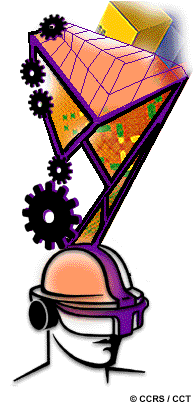Proactive disclosure
Print version   |  | 
Natural Resources Canada > Earth Sciences Sector > Priorities > Canada Centre for Remote Sensing
Viewing Methods in 3-D

3-D observation methods |
Since prehistoric times people have attempted to reproduce what they see naturally through drawing,
painting and sculpture. In order to overcome the limitations of two-dimensional surfaces, psychological
cues such as perspective, shade and shadows have traditionally been used to create an illusion of
three-dimensionality. In the last 200 years, mechanical-optical and digital 3-D imaging methods capitalizing on the physiological cues of binocular parallax and convergence have been developed. Prior to the invention of holography, three-dimensional imaging techniques such as stereoscopy relied on these two cues. The following sections describe some commonly used 3-D imaging methods and systems,
especially those related to remote sensing.
|
